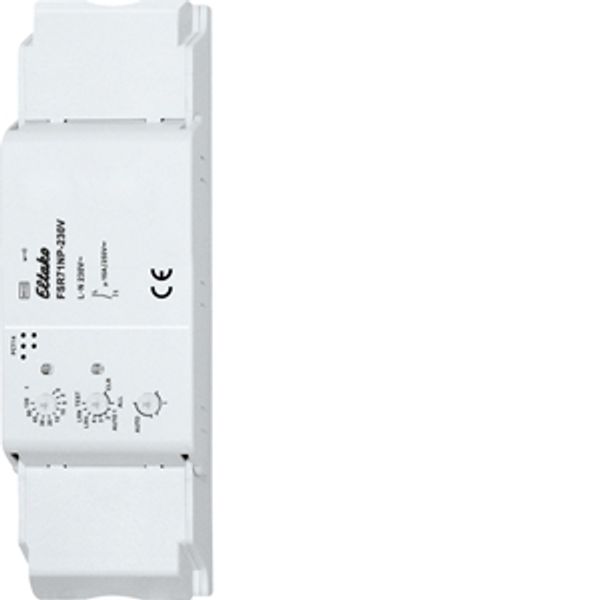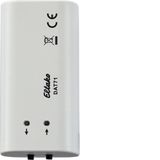Register to unlock your exclusive B2B prices and start shopping. Sign up now!
Wireless actuator impulse switch with integr. relay function 30100865
In stock: No
Vendor stock: No
Minimal order quantity: 1
Price (excl. VAT):
79,19 €
EAN: 4010312316221
MPN: 30100865
Package: 1
Technical Information
| Item condition | New |
| Manufacture name | Wireless actuator impulse switch with integr. relay function 30100865 |
| Brand | ELTAKO |
| Categories |
Switches
|
| Country of origin | CN |
| Harmonized System Code | 8526 9200 00 |
| Mounting method | Other |
| Colour | White |
| Halogen free | Yes |
| Surface protection | Other |
| Current supply | 230 V AC |
| Number of relays | 1 |
| Suitable for switch | Yes |
| Suitable for pulse button | Yes |
| Suitable for dimmer | No |
| Suitable for roller shutter switch | No |
| Material quality | Thermoplastic |
| Material | Plastic |
| Type of fastening | Other |
| Rolling code system | - |
| Number of commands | 32 |
| Radio frequency | 868 MHz |
| In housing | Yes |
| In tube base housing | No |
| Printed circuit board/module | No |
| Push button mode | Yes |
| Switching mode | Yes |
| With manual radio transmitter | No |
| With radio coding device | No |
| With radio controlled push button | No |
| Suitable for venetian-/roller shutter switch | No |
| Suitable for venetian shutter switch | No |
| Transparent | No |
| Surface finishing | Matt |
| Suitable for degree of protection (IP) | IP20 |
| IFTTT support available | No |
| Compatible with Apple HomeKit | No |
| Compatible with Google Assistant | No |
| Compatible with Amazon Alexa | No |
Packing details
| Packing level 1 | 4010312316221, 4010312316221 |
| Packing level 2 | 4010312316221 |
Downloads
Description
Impulse switch with integrated relay function, 1 NO contact not potential free 16A/250V AC, 230V LED lamps up to 400W, incandescent lamps 2000 watts. With light scene control by PC or wireless pushbuttons. Encrypted wireless, bidirectional wireless and repeater function are switchable. Only 0.8 watt standby loss. Mounting in the 230V power supply cord, e.g. in false ceilings and lamps. 166mm long, 46mm wide and 31mm high. With cable fixation. If supply voltage fails, the switching state is retained. When supply voltage is restored, the device is switched off in defined mode. Scene control: Several FSR71NP devices can be switched on or off in a scene by one of the four signals of a pushbutton with double rocker taught-in as a scene pushbutton. Central commands via app are sent using a Professional Smart Home-Controller. To do this, teach-in one or several FSR71NP devices in the respective app. Use the rotary switches to teach-in the pushbuttons and test the device as required. For normal mode, the middle and lower rotary switches are then set to AUTO. With the upper rotary switch the EW time (0-120 seconds) is directly set for relays or the RV time (0-120 minutes) for impulse switches for all channels if necessary. If wireless motion/brightness sensors FBH (Master) and/or FBH (slave) are taught-in, the switching threshold will be set with the upper rotary switch, at which the lighting will be switched on or off. Settings of the upper rotary switch in accordance with operating manual. When wireless brightness sensors are taught-in, define the switching threshold separately for each channel using the top rotary switch. The switching threshold switches the lighting on or off depending on the brightness (from approx. 0lux in position 0 to approx. 50lux in position 120). A hysteresis of approx. 300lux is permanently set for switch on/off. An additionally set RV time is not taken into account. Only one FBH (Master) or FAH is taught-in per channel. However, one FBH or FAH can be taught-in in several channels. When wireless window/door contacts FTK or window handle sensors FFG7B are taught-in, different functions can be set with the middle rotary switch in position AUTO 1 to AUTO 4 and linked to maximum 116 FTKs: AUTO 1 = window closed then output active. AUTO 2 = window open then output active. In settings AUTO 3 and AUTO 4 the FTKs taught-in to a single channel are linked automatically. With AUTO 3 all FTKs must be closed so that the N/O contact closes (e.g. for climate control). With AUTO 4 one open FTK is sufficient to close the N/O contact (e.g. for an alarm signal or to switch on the power supply for an extractor hood). One or several FTKs can be taught-in in several channels to allow several simultaneous functions in each FTK. After a power failure the link is restored by a new signal to the FTK and a signal on the next status message 15 minutes later. An additionally set RV time is not taken into account. When water probes are taught-in, a variety of functions can be set using the middle rotary switch in positions AUTO 1 to AUTO 4. AUTO 1 = no water, then NO contact closed. AUTO 2 = water, then NO contact closed. In Positions AUTO 3 and AUTO 4 the water probes taught-in to a single channel are interlinked automatically. With AUTO 3, all water probes must signal no water before the NO contact closes. The NO contact opens when a water probe signals water. With AUTO 4, the NO contact closes when a water probe signals water. Only when all water probes signal no water does the NO contact open. An additionally set RV time is ignored. The LED below the upper function rotary switch performs during the teach-in process according to the operating instructions. It shows control commands by short flickering during operation.


